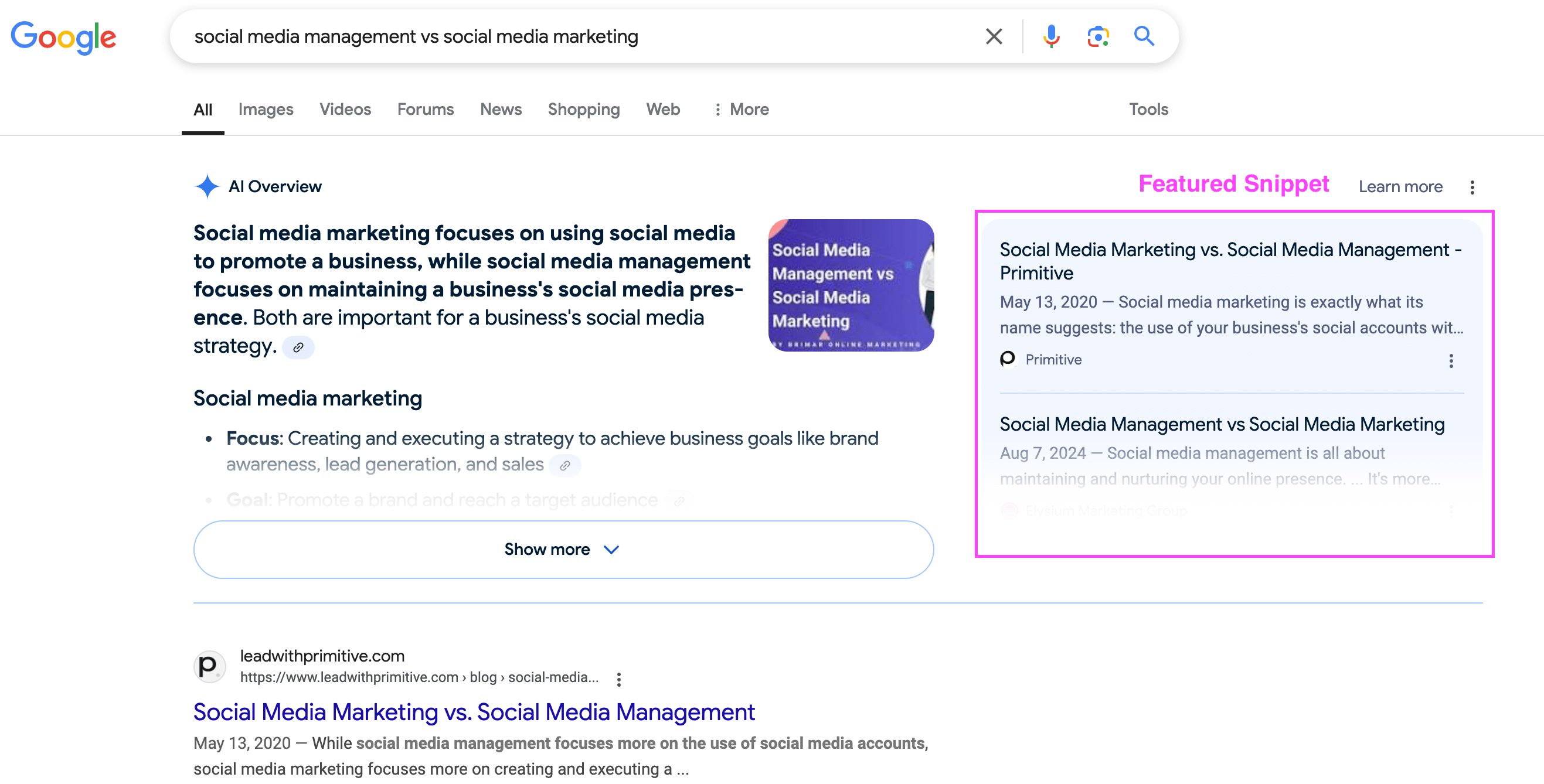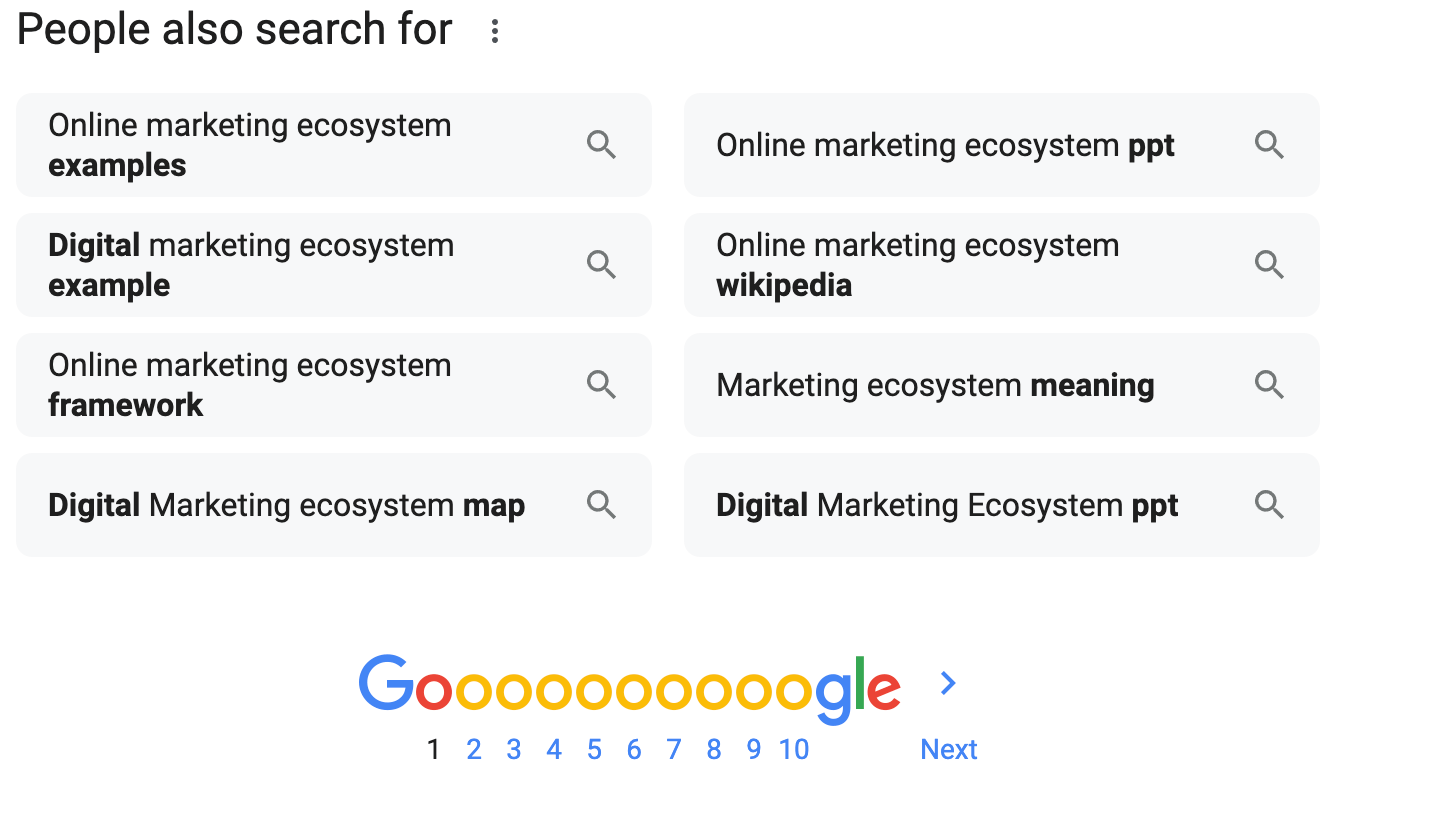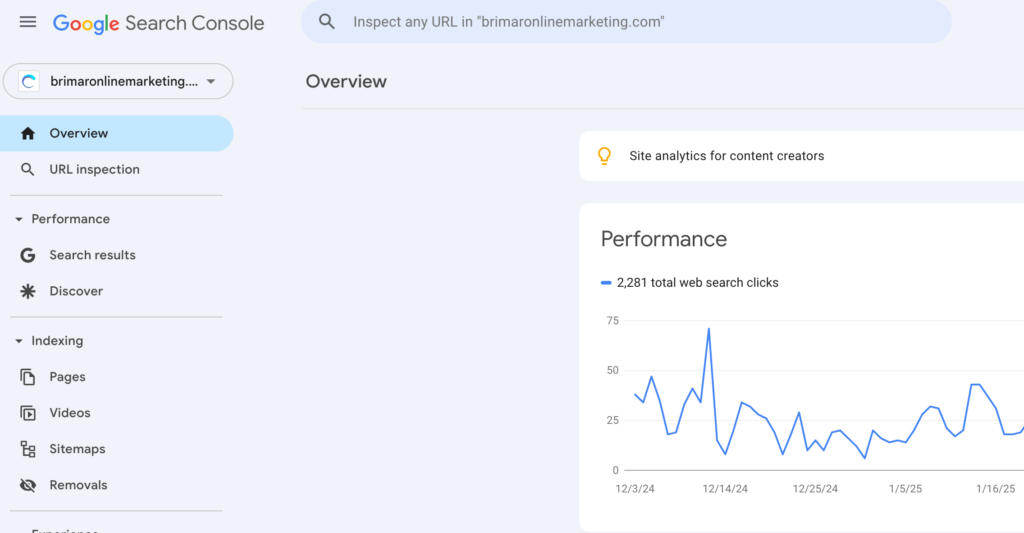
Why Featured Snippets Matter for SEO
Google Featured Snippets are the highlighted search results at the top of the search engine results page (SERP), above the first organic result.
This position, often called “position zero,” is prime real estate because it grabs attention before anything else on the page.
When a user searches for a specific query, Google pulls a direct answer from a website and displays it in a featured box.
Earning a featured snippet spot can significantly improve a website’s visibility, leading to higher click-through rates (CTR) and more organic traffic.
Unlike regular search results, featured snippets directly answer a user’s question, making them an essential part of an effective SEO strategy.
Websites that secure this position often experience authority and engagement because users perceive them as a trusted source of information.
There are four main types of featured snippets, each serving a different search intent:
- Paragraph Snippets: These offer a concise answer to a user’s question in a few sentences. They are commonly used for definitions, explanations, and quick facts.
- List Snippets: These appear as bullet points or numbered lists, ideal for step-by-step guides, checklists, and ranked lists.
- Table Snippets: These display structured data in a tabular format, commonly used for comparisons, pricing, or statistics.
- Video Snippets: These pull content from YouTube videos, often appearing for tutorial-based or how-to searches.
Optimizing for featured snippets isn’t just about writing content; it’s about structuring information so that Google’s algorithm understands and ranks as the best answer for a user’s query.
By targeting the right keywords and presenting valuable insights in an easy-to-digest format, content creators can increase their chances of securing this coveted spot on Google’s first page.
Understanding the Different Types of Google Featured Snippets

Google doesn’t just pull any random content for featured snippets.
The algorithm selects the most relevant, well-structured content that answers a searcher’s question directly.
Understanding the different types of snippets helps tailor content to match Google’s ranking criteria.
Start Attracting Customers Through SEO Today!
We can help you attract new customers through Tailored Search Engine Optimization Strategies for Your Business.
Paragraph Snippets
These represent the most frequently seen type of featured snippet.
Google extracts a concise, direct answer from a webpage and displays it in a short paragraph, typically 40-60 words.
These snippets usually answer what, why, and how questions.
For instance, when someone searches “What is content marketing?”, Google might pull a short definition from a well-optimized blog post.
To improve the chances of ranking for a paragraph snippet, content should:
- Include a clear, direct answer within the first few sentences of the paragraph.
- Use natural language that matches how people phrase their search queries.
- Format the content with strong headers (H2, H3) to help Google identify key sections.
List Snippets
Google features bullet points or numbered lists when a search query implies a step-by-step process, a ranking, or a checklist.
Searches like often trigger these snippets:
- “How to create a blog post” (step-by-step process).
- “Best SEO tools for keyword research” (ranked list).
- “Checklist for website optimization” (unordered list).
To optimize for list snippets, content should:
- Use H2 or H3 subheadings for each step or item in the list.
- Format the answer in bullet points or numbered lists.
- Keep each point brief and informative.
Table Snippets
These snippets pull structured data into a table format to provide comparisons, numerical data, or specifications.
Queries that often trigger table snippets include:
- “SEO pricing comparison”
- “Conversion rate benchmarks by industry”
- “Facebook ad costs by region”
To optimize for table snippets, content should:
- Include a well-formatted HTML table within the blog post or web page.
- Use schema markup to help Google recognize the data structure.
- Keep the table simple, clear, and informative.
Video Snippets
When Google determines that a video tutorial provides the best answer to a query, it pulls content directly from YouTube videos.
These snippets are commonly triggered by “how-to” searches like:
- “How to bake sourdough bread”
- “Best way to optimize a WordPress website”
- “SEO strategies for local businesses”
To increase the chances of getting a video snippet, content creators should:
- Enhance video titles, descriptions, and tags with pertinent keywords.
- Add timestamps to break the video into clear sections.
- Include a video transcription to enhance Google’s understanding of the content.
Each type of featured snippet meets a different search intent, and Google selects the best format based on the query.
Knowing how to structure content for Google snippets is key to ranking at the top of Google search results.
How to Find and Target Snippet Opportunities
Securing a featured snippet spot starts with finding the right opportunities.
Google isn’t going to feature content that doesn’t align with user intent or provide useful information.
The key is targeting the right keywords, correctly structuring content, and understanding what Google already features.
Use Keyword Research Tools
Not all keywords trigger featured snippets, so using keyword research tools like Ahrefs, SEMrush, or Google Keyword Planner to identify snippet-worthy search queries is essential.
Look for:
- Long-tail keywords that include specific questions.
- Keywords where Google already shows a featured snippet (these indicate strong opportunities).
- Queries that align with user intent—whether informational, navigational, or transactional.
Analyze Google Search Console
Google Search Console provides insights into which search queries are already bringing traffic to a website.
By analyzing existing rankings, content creators can:
- Identify pages that rank in the top 10 but don’t yet have a featured snippet.
- Optimize those pages by providing clear, structured answers in the best format (paragraph, list, table, or video).
- Test different content structures to see what works best.
Focus on Related Questions (People Also Ask Section)

Google’s “People Also Ask” section provides a goldmine of snippet opportunities.
These related questions often lead to featured snippet rankings if the content is structured correctly.
To optimize for these queries:
- Incorporate direct answers to the most relevant questions.
- Use H2 and H3 headers that mirror the exact phrasing of the related questions.
- Expand on each answer to provide additional valuable insights while keeping the response concise.
The best way to rank for featured snippets is to align content with search intent and structure answers effectively.
By analyzing Google’s search feature, optimizing existing content, and using keyword tools, content creators can dramatically improve their chances of securing the top spot in organic search results.
The Best Way to Optimize Content for Featured Snippets
Ranking for a Google Featured Snippet isn’t just about writing great content; it’s about structuring it in a way search engines can easily understand and display.
Here’s how to give your content the best chance of earning a featured snippet spot and boosting your website’s visibility.
Content Structure Matters
Search engines prioritize content that is well-organized and easy to digest.
Information structure can make or break your chances of appearing in Google snippets.
- Use clear headings and subheadings to break up content logically. Google favors well-structured pages that provide direct answers without unnecessary fluff.
- Place the most relevant answer within the first few sentences of a web page or blog post. The goal is to provide quick answers so users and search engines can quickly identify them.
- Keep paragraphs concise and avoid long, complex sentences. The more precise your response, the better chance you have of ranking.
On-Page SEO Best Practices
To increase organic traffic and optimize for Google’s algorithm, technical SEO elements play a key role.
- Schema markup helps search engines better understand the content and improves the likelihood of appearing in rich snippets. Adding structured data can make a piece of content more appealing to search engines.
- Use unordered lists, list format, and tabular format where applicable. List snippets and table snippets are among the most common search features Google highlights.
- Write in natural language, focusing on how users ask questions. The best-performing Google snippets provide concise, informative answers using the user’s query as a guide.
Snippet Optimization Techniques
Fine-tuning your content for search snippets requires strategically placing precise answers and ensuring Google can extract the best information from your page.
- Position quick answers at the top of the page whenever possible. Google-featured snippets prioritize content that delivers the best answer upfront.
- Make sure your content provides relevant answers to the user’s search query. Avoid generic responses—searchers are looking for valuable insights.
- Consider mobile-friendliness. Many voice search results pull information from Google snippets, so pages must load quickly and display well on mobile devices.
Step-by-Step Guide to Creating Content That Wins Featured Snippets
Appearing in Google snippets requires a mix of keyword research, content optimization, and formatting.
Here’s how to craft content that earns the top spot on the search engine results page.
1. Conduct Keyword Research to Find Snippet Opportunities
The best way to rank for a featured snippet is by identifying search queries that already trigger one.
Use keyword research tools to find long-tail keywords and search snippets where competitors are ranking.
2. Create SEO-Friendly Blog Posts with Direct Answers
Google favors content that answers specific questions.
To increase your chances of being featured:
- Include concise answers within the first few sentences of the post.
- Use high-quality content that aligns with search intent.
- Format answers to match common types of snippets (paragraph, list, table, or video).
3. Use Step-by-Step Instructions and Bullet Points
- List format is one of the most common types of featured snippets.
- Provide step-by-step instructions where applicable.
- Use bullet points to summarize key takeaways.
4. Optimize Video Content for Google Snippets
- Video snippets are often featured for tutorials and how-to searches.
- Use YouTube videos with clear titles, descriptions, and transcriptions to improve snippet eligibility.
- Add timestamps to specific sections of the video that answer user queries.
5. Test Different Content Formats
- Some search queries perform better with list snippets, while others work best as paragraph snippets or table snippets.
- Monitor how different formats impact rankings and make adjustments accordingly.
Leveraging Google Search Console and Analytics for Snippet Success

Once your content is optimized, the next step is tracking performance and refining your approach.
Track Featured Snippet Opportunities with Google Search Console
- Identify which search engine results page (SERP) features your content appears in.
- Find pages that rank in the top 10 but haven’t yet captured a featured snippet spot.
Analyze Search Queries and Adjust Content Strategy
- Look for search queries where users engage with your content but don’t click through.
- Refine your content structure to improve click-through rates and organic keywords rankings.
Optimize for Higher Click-Through Rates and Better Visibility
- Make sure your snippet-friendly content stands out with relevant keywords.
- Adjust headings and content formatting to match what Google prefers for featured snippets.
Understanding search intent, structuring content appropriately, and continuously refining your SEO strategy are the keys to ranking for Google-featured snippets.
With the right approach, you can turn your website into a powerful tool for capturing prime real estate at the top of Google search results.
Mistakes to Avoid for Featured Snippet Optimization
Getting a featured snippet can significantly boost a website’s visibility, but many businesses miss out because of a few common mistakes.
Google prioritizes content that provides clear, structured, and relevant answers, and failing to meet these criteria can cost a spot in search results.
Here’s what typically goes awry and how to resolve it.
Not Answering the User’s Search Query Directly
One of the biggest mistakes is failing to provide a concise, direct answer to the searcher’s question.
Google scans content for quick answers that match search intent.
It won’t get selected if the response is buried in long paragraphs or lacks clarity.
A good strategy is to answer the question in the first few sentences and then expand on it in the rest of the content.
Use simple, natural language and avoid unnecessary jargon.
If the query requires a list, table, or bullet points, format it accordingly to increase visibility.
The goal is to make it as easy as possible for Google to recognize your content as the best response.
Ignoring Content Structure
Content that isn’t correctly structured is less likely to appear in featured snippets.
Using clear headings, subheadings, bullet points, and numbered lists, Google favors well-organized information.
For example, if a blog post covers a step-by-step guide, it should be formatted as a list snippet rather than a text block.
A table snippet is more effective if a topic involves comparisons or numerical data.
This simple formatting change can differ between ranking at the top or getting overlooked.
Another key element is schema markup.
While not required, it helps Google understand content structure and improves snippet optimization.
This minor adjustment gives content a better chance of securing the featured snippet spot.
Neglecting Voice Search Results
Voice search is growing, and featured snippets are significant in delivering direct answers to voice queries.
Most voice search results come from Google-featured snippets, meaning content needs to be optimized for natural, conversational language.
Many websites fail to consider how people phrase user queries in voice search.
Instead of typing “best way to lose weight,” someone using voice search might ask, “What’s the best way to lose weight fast?”
Optimizing for long-tail keywords and specific questions makes it more likely for content to appear in voice search results.
Another missed opportunity is failing to provide concise answers.
Google prefers short, clear responses for voice search, so content should start with a direct answer and then provide a detailed explanation.
Fixing these mistakes can make a significant difference.
Businesses that focus on answering queries directly, structuring content appropriately, and optimizing for voice search have a much higher chance of securing a featured snippet and improving organic traffic.
The Future of Featured Snippets in SEO Strategy
Securing a featured snippet spot isn’t just about ranking high; it’s about owning the conversation in search results.
Businesses that optimize their content for snippets see higher click-through rates, better visibility, and more organic traffic.
A strong SEO strategy includes structuring content to match user intent, providing quick answers, and leveraging search feature formats like list snippets, table snippets, and paragraph snippets.
Snippet optimization isn’t a one-time effort.
It requires constant updates based on Google’s algorithm changes, ensuring content remains relevant.
On-page SEO, content structure, and search intent should always be priorities.
Websites consistently offering valuable insights, precise answers, and well-formatted content are more likely to appear in featured snippets.
Businesses that ignore this opportunity are wasting traffic.
Snippets are a powerful tool for improving organic search results, and those who take the time to optimize their content correctly will continue to benefit from better visibility in search engines.
Staying ahead means watching Google Search Console, tracking snippet opportunities, and refining content strategies based on user experience.
The websites that adapt will continue to dominate the top of Google search results while the competition struggles to keep up.
Our SEO Services Have Helped Our Clients Increase Their Revenue!
“I highly recommend Brimar if your looking to grow your online business. You will be satisfied with the high level of expertise and high quality of services. It has helped my business grow by leaps and bounds.”
CEO

